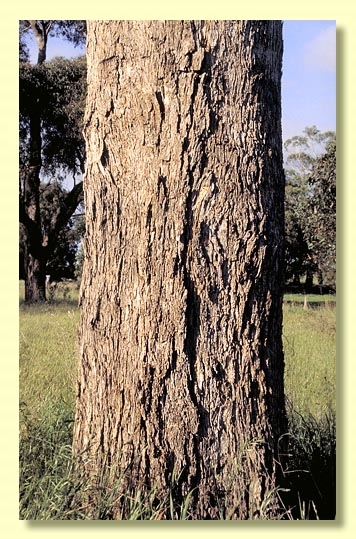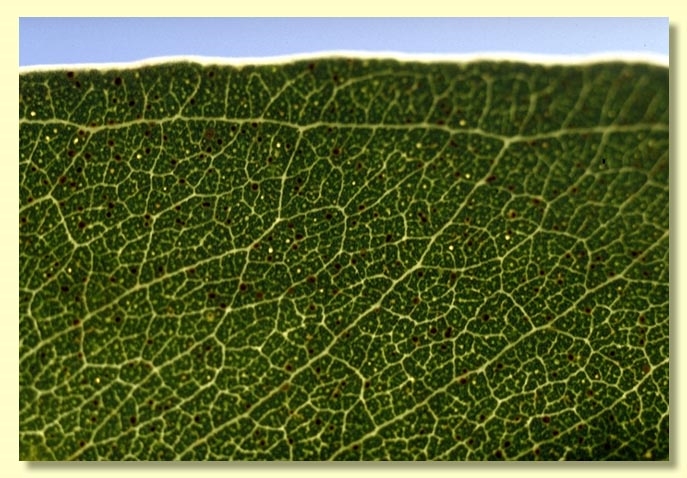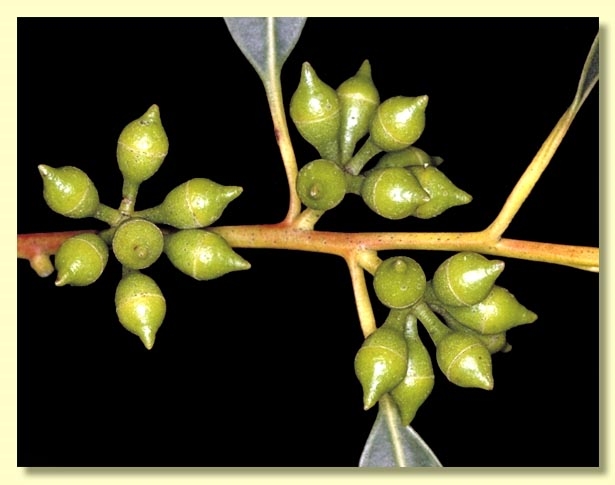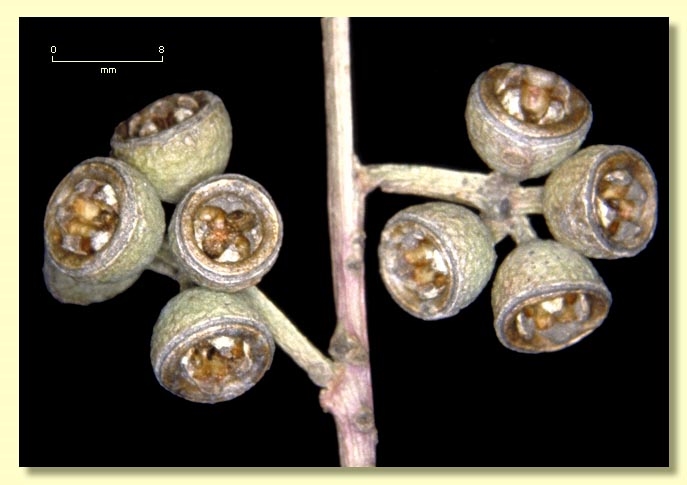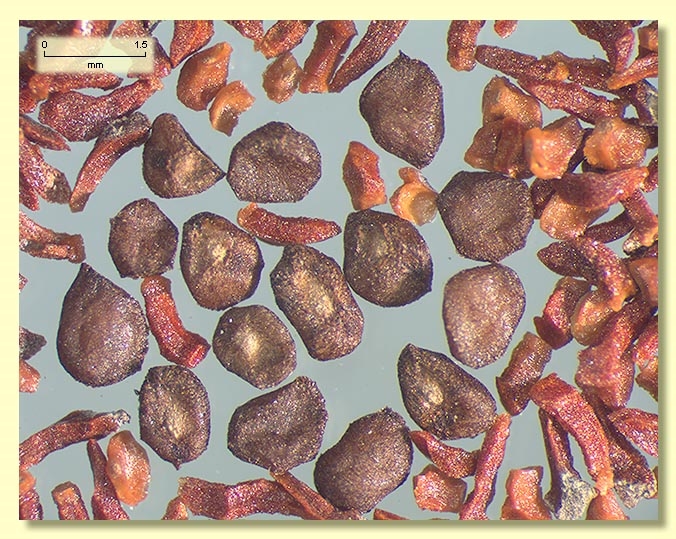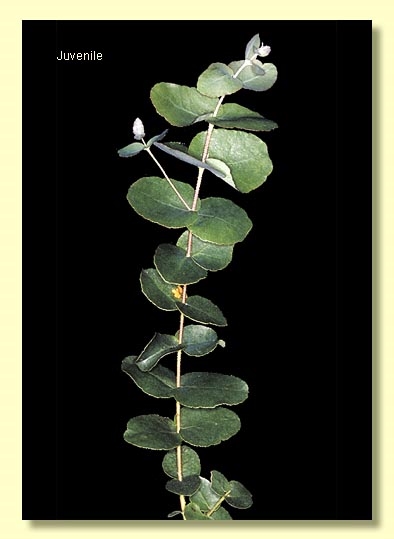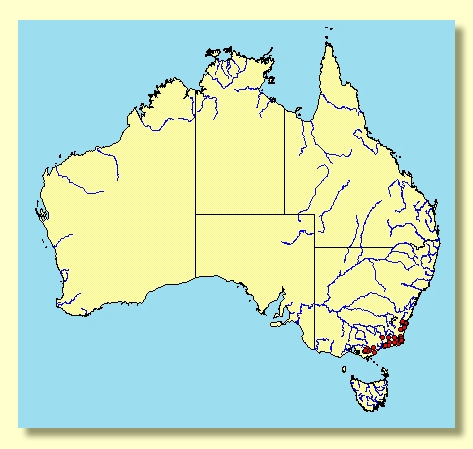Euclid - Online edition
Eucalyptus angophoroides
Eucalyptus | Symphyomyrtus | Maidenaria | Euryotae | Bridgesiana
T: Colombo, NSW, W.Bäuerlen s.n.; lecto: NSW, fide J.H.Maiden, Crit. Revis. Eucalyptus 5: 185 (1921).
Bark rough on trunk and branches, shortly and closely fibrous, often tessellated, grey, or mottled with grey and white patches, horizontal black scars sometimes present on trunk.
Juvenile growth (coppice or field seedlings to 50 cm): stem rounded or square in cross-section, green or glaucous, warty, new growing tips glaucous; juvenile leaves opposite, sessile for many pairs, becoming sub-opposite, shortly petiolate, orbicular to ovate or cordate, 1.7–7 cm long, 1.5–5.5 cm wide, margin crenulate, discolorous (greenish above and paler, slightly glaucous below).
Adult leaves alternate, petiole 1–3.8 cm long; blade lanceolate to falcate, 8–25 cm long, 1.4–4.3 cm wide, base sometimes oblique but usually tapering evenly to petiole, margin entire, discolorous or rarely concolorous, glossy, green, side-veins greater than 45° to midrib, moderately to densely reticulate, intramarginal vein parallel to and just within margin or some distance from it, oil glands numerous, small, island and intersectional.
Inflorescence axillary unbranched, peduncles 0.3–1 cm long, buds 7 per umbel, pedicels 0.2–0.7 cm long. Mature buds ovoid, 0.7–0.9 cm long, 0.3–0.6 cm wide, green to yellow, scar present, operculum conical to beaked, stamens irregularly flexed, anthers cuboid or cuneate, versatile, dorsifixed, dehiscing by longitudinal slits (non-confluent), style long, locules 3 or 4, the placentae each with 4 vertical ovule rows. Flowers white.
Fruit on pedicels 0.1–0.6 cm long, cup-shaped or hemispherical, 0.4–0.5 cm long, 0.5–0.9 cm wide, sometimes slightly angled longitudinally, disc raised or level, rarely slightly descending, valves 3 or 4, strongly exserted.
Seeds blackish, brown or grey, 1–2.2 mm long, ovoid or flattened-ovoid, usually lacunose, dorsal surface shallowly pitted, hilum ventral.
Cultivated seedlings (measured at ca node 10): cotyledons bilobed; stems rounded in cross-section, warty, sometimes glaucous; leaves opposite for many nodes, sessile or very shortly petiolate, cordate, 3–7 cm long, 2–4 cm wide, margin crenulate, discolorous, green above, paler or glaucous below.
Flowering has been recorded in January, February and December.
A small to medium-sized apple box tree of south-eastern coastal New South Wales and Victoria from the Strzelecki Range eastwards. It has typical box-type bark but is unrelated to the true box species. Eucalyptus angophoroides has green juvenile leaves, slightly discolorous adult leaves and four valves to the fruit, which distinguishes it from the related tableland species, E. bridgesiana, which has sub-opposite to alternate, glaucous juvenile leaves, concolorous adult leaves and usually three valves to the fruit. The third species of the group is E. dunnii, a tall tree of the far Northern Tablelands of New South Wales, differing in being mostly smooth-barked and in having green juvenile leaves. The fourth species of the group, E. malacoxylon, restricted to the Moonbi area north of Tamworth, can be easily distinguished from the others by the presence of a prominent median flange where the operculum joins the hypanthium, and it usually has coarser glaucous buds and fruit.
E. angophoroides belongs to Eucalyptus subgenus Symphyomyrtus section Maidenaria, a large group of species more or less restricted to south-eastern Australia, characterised by bilobed cotyledons, simple axillary inflorescences, buds with two opercula, stamens with versatile anthers and flattened seeds with a ventral hilum. Within this section E. angophoroides belongs to a small group, series Bridgesianae, further characterised by rough bark becoming tessellated, ovate, crenulate juvenile leaves, buds in sevens and fruit with exserted valves. There are four species in series Bridgesianae—E. bridgesiana, E. dunnii, E. malacoxylon and E. angophoroides. The differences are outlined above.


